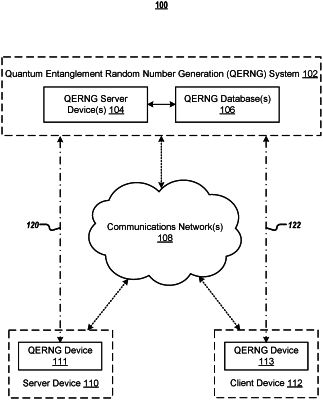| CPC H04L 9/0858 (2013.01) [G06F 7/588 (2013.01); H04L 9/0631 (2013.01); H04L 9/0855 (2013.01); H04L 9/0869 (2013.01); H04L 9/14 (2013.01)] | 20 Claims |

|
16. A method for quantum entanglement random number generation, the method comprising:
identifying a quantum basis from a set of quantum bases;
providing an indication of a basis vector that forms a basis of a state space comprising a quantum state of a first set of entangled quantum particles and a second set of entangled quantum particles based on the quantum basis, wherein one or more quantum particles in the first set of entangled quantum particles is entangled with a respective quantum particle in the second set of quantum particles associated with the second computing device;
transmitting an electronic identification of a subset of the first set of entangled quantum particles and the set of quantum bases to a second computing device;
receiving a quantum computing (QC) detection alert control signal, a leakage alert control signal, or a tampering alert control signal;
in response to receipt of the QC detection alert control signal, the leakage alert control signal, or the tampering alert control signal, and within a defined duration of time corresponding to an associated QC threat, measuring at least the subset of the first set of entangled quantum particles;
generating a quantum entanglement random number based on the measured subset of the first set of entangled quantum particles;
generating a cryptographic key based on the quantum entanglement random number;
encrypting an electronic communication based on the cryptographic key; and
transmitting the encrypted electronic communication to the second computing device.
|